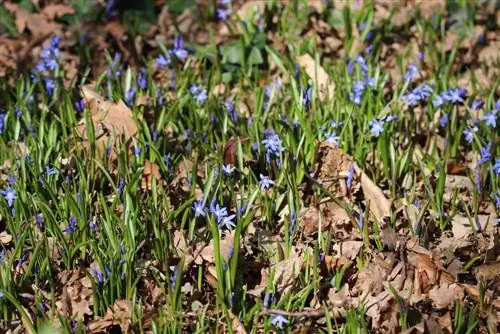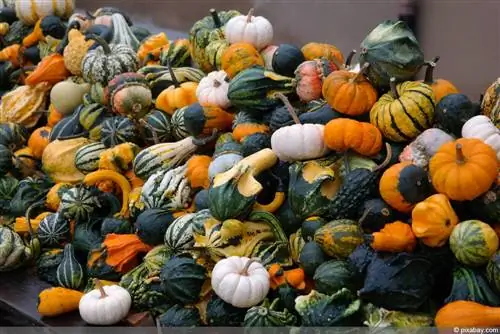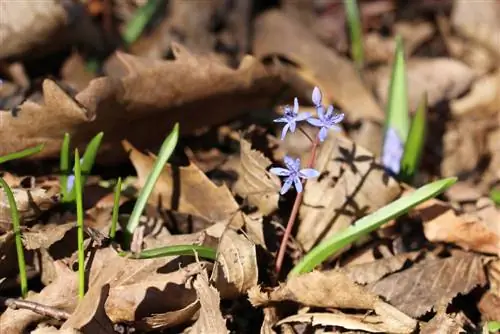- Author admin [email protected].
- Public 2023-12-17 03:39.
- Last modified 2025-01-24 12:45.
In early spring, the cheerful squill opens the colorful dance of fresh spring flowers. As a classic early bloomer, Scilla bifolia thrives tirelessly under tall trees, colonizes extensive park areas as a ground cover or decorates the lawn with its pretty starry flowers. With their graceful unobtrusiveness, star hyacinths create a dreamy echo in the visual appearance in almost all locations in the garden. As the following instructions for proper planting, care and propagation show, the squill is rightly considered a paragon of frugality.
Profile
- Plant genus squill (Scilla)
- Species: Two-leaved squill (Scilla bifolia)
- Native to the Mediterranean region, southern and central Germany
- Winter-hardy onion plant with an average of 5 leaf years
- Growth height 5 to 15 centimeters
- Blue or white star flowers
- Flowering period from March to April
- Two shiny green leaves grow per stem
- Other names: squill, star hyacinth
- Poisonous in all parts due to harmful saponins
In Germany, wild squills are subject to the Federal Species Protection Ordinance. You can enjoy the magical picture in the great outdoors. However, picking or even digging up is prohibited.
Location and soil
Scilla bifolia demonstrates its flexibility and adaptability in the long term if you consider the criteria for a suitable location:
- Sunny to partially shaded areas
- Optionally a location in light shade under deciduous trees
- Nutritious, humus-rich, fresh, moist soil
- Also sandy-loamy, without too much dryness
The limit of the natural distribution area is in the Siebengebirge near Bonn. This suggests that squills might have a hard time in gardens further north.
Plants
So that the early bloomers develop their full potential and actually shine in front of the primroses or larkspur, the ideal planting time is from the beginning of September to mid-October. If the soil conditions at the chosen location are not optimal, a soil improver is incorporated, such as compost in lean soil or sand in heavy soil. On this occasion, the soil is raked into fine crumbs and cleaned of roots or stones. This is how the planting is done step-by-step:
- Dig out small planting holes approx. 10 centimeters deep
- Insert the flower bulb with the tip upwards, surround it with soil and press down
- Ideally plant in small tuffs 10 centimeters apart
After watering sparingly, experienced hobby gardeners treat the squills to a layer of mulch made of leaves, straw or compost so that they get through the winter safely.
Tip:
In conjunction with snowdrops, haredrops, larkspurs and squills, you can create a colorful plant composition with squills.
Care
Until the small flower dwarfs appear in spring, they do not require any care attention. As the soil progresses, it should be kept constantly moist without becoming waterlogged. If you are already out in the garden with a wheelbarrow full of compost, thank Scilla bifolia for a portion of nutrients with additional vitality. However, the administration of fertilizer is not absolutely necessary. Pruning close to the ground is only carried out when the flowers and leaves have completely withered. Until then, the onion will assimilate all remaining nutrients to create a reserve for the next year.
Tip:
Wear gloves during all planting and care work so that the toxic saponins do not harm you.
Propagate

Blue starlets are true masters of vegetative propagation. They owe this fact, on the one hand, to the numerous breeding bulbs and, on the other hand, to the capsule fruits. Once you're there, you can safely leave it to the plant to spread further. If you aim to cultivate at other locations, you can breed using the following two methods:
Sowing
The pure species can be easily propagated by collecting fruits yourself, from which you can remove the delicate seeds when completely dried. If you are cultivating a variety and want it to be propagated in an identical habit, purchasing certified seeds from specialist retailers is recommended. This is how sowing works:
- Fill small 6 cm pots with peat sand, perlite, expanded clay or coconut fiber
- Spread the seeds evenly over the substrate
- Sift thinly with sand or vermiculite and spray with water
- Cover seed containers with foil or put them in the greenhouse
Germination occurs quickly in a partially shaded window seat at a temperature of 23 to 26 degrees Celsius. Seeds and substrate must not dry out. Ideally, you water from below so that the delicate seeds are not washed away. To do this, place the pots in a few centimeters of water and let the capillary action do the rest. If the substrate surface feels moist, the watering process is finished and the seed pots are removed from the water. If the cotyledons emerge from the seeds, the cover is ventilated daily until it is completely removed. When the first real leaves thrive, the squills are transplanted into individual pots with lightly fertilized substrate.
Growing onions
Propagation is even more straightforward using brooding onions. If you dig up a flower bulb after it has bloomed, you can recognize different daughter bulbs. Cut these off with a disinfected, sharp knife. Store the propagating material in a dry and dark place until planting time in autumn.
Cultivation as an annual houseplant
Would you like to enjoy the magical squills in your house? Then there's nothing wrong with cultivating it as a houseplant on the windowsill for the first year. Then plant Scilla bifolia outdoors so that it can continue to display its cheerful play of colors for several years to come. This is how the one-year intermezzo behind glass succeeds:
- In autumn, fill a flower pot with commercially available substrate for houseplants
- Insert the onions 10 centimeters deep, with the tip upright
- Cover with soil, press lightly and water moderately
- Place for 10 to 12 weeks in a cool, dark cellar at temperatures not below 10 degrees Celsius
During the dark phase, check every 14 days whether the substrate is still moist. Only add enough water to ensure that the soil does not dry out. Once budding begins, gradually accustom the star hyacinths to brighter light and warmer temperatures. The amount of irrigation water is now increased proportionally to growth. The longest flowering period occurs at temperatures around 15 degrees Celsius. Of course, squills also thrive at higher temperatures, but then for a little shorter time.
Conclusion
Squills are the first early bloomers to drive away the gray dreariness of winter. Planted at the right time in September or October, the graceful starry flowers shine as early as March. Without requiring extensive care, the robust, mass-flowering bulbs form dense cushions covered in blue colors. As long as star hyacinths are not exposed to drought stress, they fulfill their task in the garden brilliantly. Propagation is also very easy to do by hand, either by sowing or breeding bulbs.





